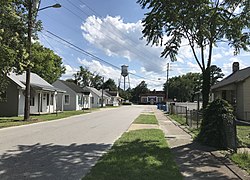2000 census
As of the census [4] of 2000, 11,237 people, 4,112 households, and 3,108 families were living in the town. The population density was 1,844.6 inhabitants per square mile (712.2/km2). The 4,497 housing units averaged 738.2 per square mile (285.1/km2). The racial makeup of the town was 73.04% White, 17.61% African American, 2.03% Native American, 1.26% Asian, 0.21% Pacific Islander, 2.77% from other races, and 3.08% from two or more races. Hispanics or Latinos of any race were 6.40% of the population.
Of the 4,112 households, 46.4% had children under the age of 18 living with them, 54.0% were married couples living together, 17.4% had a female householder with no husband present, and 24.4% were not families. About 19.7% of all households were made up of individuals, and 5.3% had someone living alone who was 65 years of age or older. The average household size was 2.73, and the average family size was 3.13.
In the town, the age distribution was 32.1% under 18, 8.2% from 18 to 24, 37.0% from 25 to 44, 16.8% from 45 to 64, and 5.8% who were 65 or older. The median age was 31 years. For every 100 females, there were 90.4 males. For every 100 females age 18 and over, there were 85.9 males.
The median income for a household in the town was $40,697, and for a family was $44,866. Males had a median income of $34,120 versus $21,845 for females. The per capita income for the town was $16,534. About 5.7% of families and 7.8% of the population were below the poverty line, including 8.7% of those under age 18 and 13.7% of those age 65 or over.





